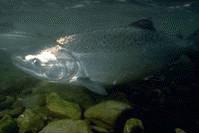Pollock Fleet Struggles With Bycatch as Season Closes

Thursday, October 27 2011
The Bering Sea pollock B season is grinding to a close.
As of Saturday, 77,000 metric tons of fish remain unharvested. That’s about 10 percent of what the fleet’s allowed to take this fall. Both the catcher vessels and factory trawlers have reduced their effort substantially, according to NOAA’s latest catch report. Many crews have already packed up and flown home even if they still have fish on the table.
Camilo Neto is the captain of the Starward, and his crew left the island on Tuesday. He says that with the sluggish pace of fishing, the low price, and the high cost of fuel, it just wasn’t profitable to ride out the rest of the season. He adds that the fleet has also been hampered by chinook salmon bycatch, something that hasn’t been a problem in shorter seasons.
“Because fishing’s been so slow, we’re fishing late and now we’re catching the chinooks when they’re coming through,” says Neto.
According to Karl Haflinger with Sea State, some boats have seen deliveries with over 100 chinook salmon in them.
“There have been years where in A seasons and B seasons it’s just really rare to get those many salmon in a delivery,” says Haflinger.
As the head of Sea State, Haflinger monitors salmon bycatch in the pollock fishery in real-time. He says that more salmon is being taken than previous years, but it’s hard to do a true comparison since usually boats aren’t fishing this late.
“For the last several years, nearly everyone’s been finished at this point in time,” says Haflinger. “So, they weren’t there on the grounds to give us any idea of what the salmon levels were like.”
As of October 15, about 19,000 chinook salmon had been taken as bycatch. That’s well below the 60,000-fish hard cap that would trigger a shutdown of the fishery. But some vessels have gotten close to their base caps, which has put them on edge for the coming A season.
“I just don’t know that anyone’s actually gone ahead and limited out at that upper level because I think they’d be concerned about what kind of hole they would be starting with next year,” says Haflinger. “I don’t know that anybody’s felt that the fishing’s been good enough to justify using that much salmon.”
Additionally, the pollock fleet has taken over 175,000 chum salmon – fourteen times what they took last year.
The season closes at noon on Tuesday.



